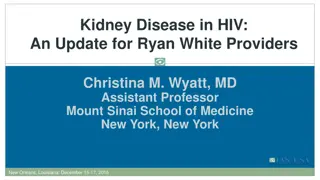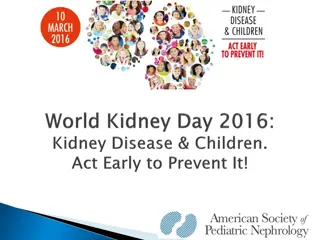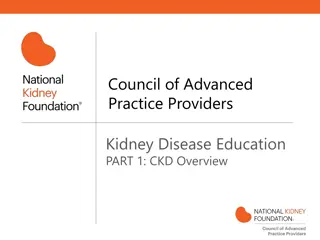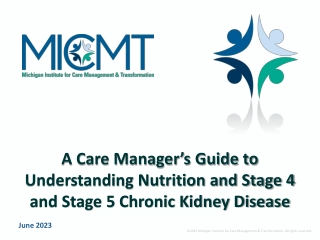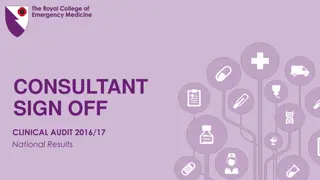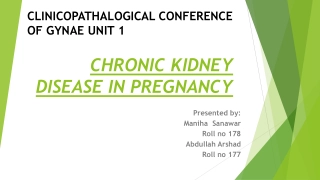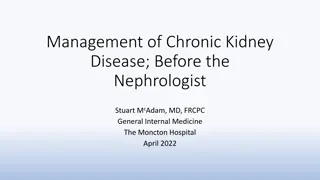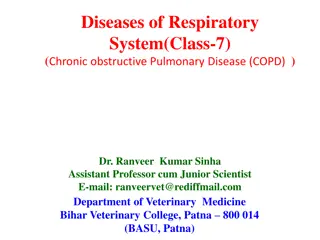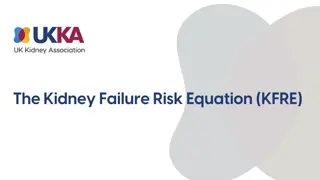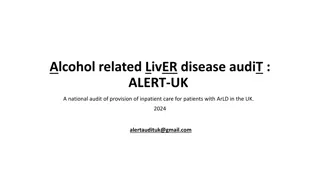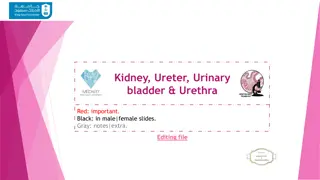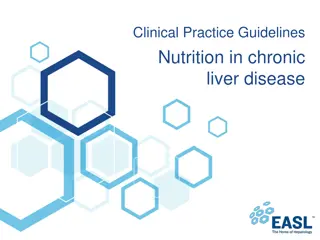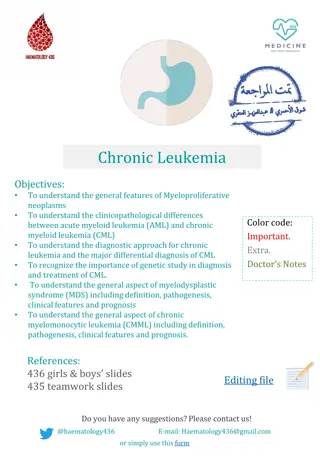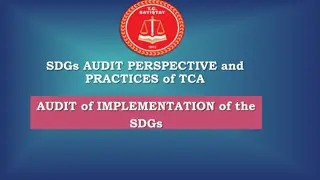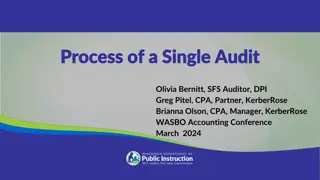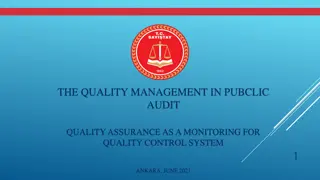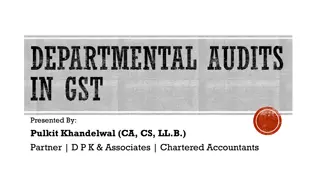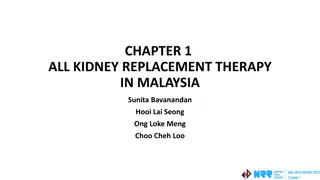National Chronic Kidney Disease Audit Overview
This presentation outlines the aims and focus areas of the National Chronic Kidney Disease Audit (NCKDA) in primary care settings. It covers the identification, management, and outcomes of CKD patients, with a particular emphasis on performance against NICE quality standards. The report is divided into sections focusing on the initial review of CKD identification and management, as well as outcomes such as referrals, hospital admissions, and mortality rates for CKD patients. Utilizing Informatic Audit Plus software, the audit aims to achieve coverage rates above 75% in participating practices.
Download Presentation

Please find below an Image/Link to download the presentation.
The content on the website is provided AS IS for your information and personal use only. It may not be sold, licensed, or shared on other websites without obtaining consent from the author. Download presentation by click this link. If you encounter any issues during the download, it is possible that the publisher has removed the file from their server.
E N D
Presentation Transcript
Analytical Team Writing Team Faye Cleary Lois Kim Dr Sally Hull Dr Ben Caplin Professor Dorothea Nitsch Kathleen Mudie Faye Cleary Dr Ben Caplin Professor David Wheeler Dr Sally Hull Professor Dorothea Nitsch
Aims Map of coverage of NCKDA within practices using Informatic Audit Plus software >75% of possible Aims: 50 75% 25 50% <25 % No possible participants To review identification and management of CKD in primary care To describe patient outcomes Measures: Performance against NICE quality standards Variation
Aims Map of coverage of NCKDA within practices using Informatic Audit Plus software >75% of possible Aims: 50 75% 25 50% <25 % No possible participants To review identification and management of CKD in primary care To describe patient outcomes Measures: Performance against NICE quality standards Variation The National Chronic Kidney Disease (CKD) Audit provides a snapshot of performance in primary care against agreed evidence based targets
Aims Map of coverage of NCKDA within practices using Informatic Audit Plus software >75% of possible Aims: 50 75% 25 50% <25 % No possible participants To review identification and management of CKD in primary care To describe patient outcomes Measures: Performance against NICE quality standards Variation The first part of the National Report, published in January 2017, focussed on the identification and management of CKD in primary care
Aims Map of coverage of NCKDA within practices using Informatic Audit Plus software >75% of possible Aims: 50 75% 25 50% <25 % No possible participants To review identification and management of CKD in primary care To describe patient outcomes Measures: Performance against NICE quality standards Variation The second part of the report has a focus on the outcomes for people with CKD, including all referrals from GPs to nephrologists, hospital admissions, and rates of death
Aims Map of coverage of NCKDA within practices using Informatic Audit Plus software >75% of possible Aims: 50 75% 25 50% <25 % No possible participants To review identification and management of CKD in primary care To describe patient outcomes Measures: Performance against NICE quality standards Variation To do this, we linked data from the GP records with the Hospital Episode Statistics database for England and NHS Informatics Statistics for Wales for admissions, and the Office for National Statistics for information on deaths
Aims Map of coverage of NCKDA within practices using Informatic Audit Plus software >75% of possible Aims: 50 75% 25 50% <25 % No possible participants To review identification and management of CKD in primary care To describe patient outcomes Measures: Performance against NICE quality standards Variation It was originally designed to achieve full national coverage of general practices across England and Wales but
Aims Map of coverage of NCKDA within practices using Informatic Audit Plus software >75% of possible Aims: 50 75% 25 50% <25 % No possible participants To review identification and management of CKD in primary care To describe patient outcomes Measures: Performance against NICE quality standards Variation Due to technical challenges accessing primary care data, we include data from 911 practices representing approximately 74% of all Welsh practices and 8% of those in England
Aims Map of coverage of NCKDA within practices using Informatic Audit Plus software >75% of possible Aims: 50 75% 25 50% <25 % No possible participants To review identification and management of CKD in primary care To describe patient outcomes Measures: Performance against NICE quality standards Variation Still, this reflects the worldwide largest dataset addressing patients with CKD in primary care and provides insights into processes of care and data collection
Methods Prognosis of CKD by eGFR and proteinuria categories Kidney damage stage albumin/creatinine ratio Description and range A1 A2 A3 Kidney function stage eGFR (ml/min/1.73m) Description and range Normal to mild increase <30mg/g Moderate increase 30-300mg/g Severe increase >300mg/g G1 Normal or high 90 G2 Mild decrease 60-89 G3a Mild to moderate decrease 45-59 G3b Moderate to severe decrease 30-44 G4 Severe decrease 15-29 G5 Kidney failure <15 Kidney Disease: Improving Global Outcomes (KDIGO) CKD Work Group. KDIGO 2012 Clinical Practice Guideline for the Evaluation and Management of Chronic Kidney Disease. Kidney Int Suppl. 2013;3(1):1 150
Methods Prognosis of CKD by eGFR and proteinuria categories Kidney damage stage albumin/creatinine ratio Description and range A1 A2 A3 Kidney function stage eGFR (ml/min/1.73m) Description and range Normal to mild increase <30mg/g Moderate increase 30-300mg/g Severe increase >300mg/g G1 Normal or high 90 G2 Mild decrease 60-89 G3a Mild to moderate decrease 45-59 G3b Moderate to severe decrease 30-44 G4 Severe decrease 15-29 G5 Kidney failure <15 Kidney Disease: Improving Global Outcomes (KDIGO) CKD Work Group. KDIGO 2012 Clinical Practice Guideline for the Evaluation and Management of Chronic Kidney Disease. Kidney Int Suppl. 2013;3(1):1 150 CKD is often without symptoms until later stages and is only picked up by performing tests on blood and urine:
Methods Prognosis of CKD by eGFR and proteinuria categories Kidney damage stage albumin/creatinine ratio Description and range A1 A2 A3 Kidney function stage eGFR (ml/min/1.73m) Description and range Normal to mild increase <30mg/g Moderate increase 30-300mg/g Severe increase >300mg/g G1 Normal or high 90 G2 Mild decrease 60-89 G3a Mild to moderate decrease 45-59 G3b Moderate to severe decrease 30-44 G4 Severe decrease 15-29 G5 Kidney failure <15 Kidney Disease: Improving Global Outcomes (KDIGO) CKD Work Group. KDIGO 2012 Clinical Practice Guideline for the Evaluation and Management of Chronic Kidney Disease. Kidney Int Suppl. 2013;3(1):1 150 Estimated glomerular filtration rate: is the estimate of the rate at which the kidneys filter the blood of creatinine (blood test)
Methods Prognosis of CKD by eGFR and proteinuria categories Kidney damage stage albumin/creatinine ratio Description and range A1 A2 A3 Kidney function stage eGFR (ml/min/1.73m) Description and range Normal to mild increase <30mg/g Moderate increase 30-300mg/g Severe increase >300mg/g G1 Normal or high 90 G2 Mild decrease 60-89 G3a Mild to moderate decrease 45-59 G3b Moderate to severe decrease 30-44 G4 Severe decrease 15-29 G5 Kidney failure <15 Kidney Disease: Improving Global Outcomes (KDIGO) CKD Work Group. KDIGO 2012 Clinical Practice Guideline for the Evaluation and Management of Chronic Kidney Disease. Kidney Int Suppl. 2013;3(1):1 150 Albumin to creatinine ratio: is the measure of albumin leaked into the urine (urine test)
Methods Prognosis of CKD by eGFR and proteinuria categories Kidney damage stage albumin/creatinine ratio Description and range A1 A2 A3 Kidney function stage eGFR (ml/min/1.73m) Description and range Normal to mild increase <30mg/g Moderate increase 30-300mg/g Severe increase >300mg/g G1 Normal or high 90 G2 Mild decrease 60-89 G3a Mild to moderate decrease 45-59 G3b Moderate to severe decrease 30-44 G4 Severe decrease 15-29 G5 Kidney failure <15 Kidney Disease: Improving Global Outcomes (KDIGO) CKD Work Group. KDIGO 2012 Clinical Practice Guideline for the Evaluation and Management of Chronic Kidney Disease. Kidney Int Suppl. 2013;3(1):1 150 KDIGO recommends CKD be classified using a combination of blood and urine test results, and the severity of CKD is stratified into stages 1-5
Methods Prognosis of CKD by eGFR and proteinuria categories Kidney damage stage albumin/creatinine ratio Description and range A1 A2 A3 Kidney function stage eGFR (ml/min/1.73m) Description and range Normal to mild increase <30mg/g Moderate increase 30-300mg/g Severe increase >300mg/g G1 Normal or high 90 G2 Mild decrease 60-89 G3a Mild to moderate decrease 45-59 G3b Moderate to severe decrease 30-44 G4 Severe decrease 15-29 G5 Kidney failure <15 Kidney Disease: Improving Global Outcomes (KDIGO) CKD Work Group. KDIGO 2012 Clinical Practice Guideline for the Evaluation and Management of Chronic Kidney Disease. Kidney Int Suppl. 2013;3(1):1 150 KDIGO also suggests testing people who are at a high risk of developing CKD and so we looked at people with risk factors for such as diabetes or hypertension
Methods Prognosis of CKD by eGFR and proteinuria categories Kidney damage stage albumin/creatinine ratio Description and range A1 A2 A3 Kidney function stage eGFR (ml/min/1.73m) Description and range Normal to mild increase <30mg/g Moderate increase 30-300mg/g Severe increase >300mg/g G1 Normal or high 90 G2 Mild decrease 60-89 G3a Mild to moderate decrease 45-59 G3b Moderate to severe decrease 30-44 G4 Severe decrease 15-29 G5 Kidney failure <15 Kidney Disease: Improving Global Outcomes (KDIGO) CKD Work Group. KDIGO 2012 Clinical Practice Guideline for the Evaluation and Management of Chronic Kidney Disease. Kidney Int Suppl. 2013;3(1):1 150 We extracted data only from people with a CKD Read code, with risk factors for CKD, or with kidney function tests (represented approximately a quarter of the registered adult patient records) and separated the patients into two populations
Methods Prognosis of CKD by eGFR and proteinuria categories Kidney damage stage albumin/creatinine ratio Description and range A1 A2 A3 Kidney function stage eGFR (ml/min/1.73m) Description and range Normal to mild increase <30mg/g Moderate increase 30-300mg/g Severe increase >300mg/g G1 Normal or high 90 G2 Mild decrease 60-89 G3a Mild to moderate decrease 45-59 G3b Moderate to severe decrease 30-44 G4 Severe decrease 15-29 G5 Kidney failure <15 Kidney Disease: Improving Global Outcomes (KDIGO) CKD Work Group. KDIGO 2012 Clinical Practice Guideline for the Evaluation and Management of Chronic Kidney Disease. Kidney Int Suppl. 2013;3(1):1 150
Methods Prognosis of CKD by eGFR and proteinuria categories Kidney damage stage albumin/creatinine ratio Description and range A1 A2 A3 Kidney function stage eGFR (ml/min/1.73m) Description and range Normal to mild increase <30mg/g Moderate increase 30-300mg/g Severe increase >300mg/g G1 Normal or high 90 G2 Mild decrease 60-89 G3a Mild to moderate decrease 45-59 G3b Moderate to severe decrease 30-44 G4 Severe decrease 15-29 G5 Kidney failure <15 Kidney Disease: Improving Global Outcomes (KDIGO) CKD Work Group. KDIGO 2012 Clinical Practice Guideline for the Evaluation and Management of Chronic Kidney Disease. Kidney Int Suppl. 2013;3(1):1 150 We concentrate on the patient population identified as having CKD stages 3-5 - Regardless of their Read coding status - And regardless of whether they had proteinuria
Methods Prognosis of CKD by eGFR and proteinuria categories Kidney damage stage albumin/creatinine ratio Description and range A1 A2 A3 Kidney function stage eGFR (ml/min/1.73m) Description and range Normal to mild increase <30mg/g Moderate increase 30-300mg/g Severe increase >300mg/g G1 Normal or high 90 G2 Mild decrease 60-89 G3a Mild to moderate decrease 45-59 G3b Moderate to severe decrease 30-44 G4 Severe decrease 15-29 G5 Kidney failure <15 We also identified some people that would be in the top two rows-> patients who have Kidney Disease: Improving Global Outcomes (KDIGO) CKD Work Group. KDIGO 2012 Clinical Practice Guideline for the Evaluation and Management of Chronic Kidney Disease. Kidney Int Suppl. 2013;3(1):1 150 normal eGFR but have evidence of kidney damage (i.e. have other renal codes, i.e. a diagnosis of kidney disease, e.g. a Read code for CKD stage1-2, or evidence of proteinuria, but not an eGFR<60ml/min)
Methods Prognosis of CKD by eGFR and proteinuria categories Kidney damage stage albumin/creatinine ratio Description and range A1 A2 A3 Kidney function stage eGFR (ml/min/1.73m) Description and range Normal to mild increase <30mg/g Moderate increase 30-300mg/g Severe increase >300mg/g G1 Normal or high 90 G2 Mild decrease 60-89 G3a Mild to moderate decrease 45-59 G3b Moderate to severe decrease 30-44 G4 Severe decrease 15-29 G5 Kidney failure <15 Kidney Disease: Improving Global Outcomes (KDIGO) CKD Work Group. KDIGO 2012 Clinical Practice Guideline for the Evaluation and Management of Chronic Kidney Disease. Kidney Int Suppl. 2013;3(1):1 150 Amongst patients with CKD stages 1-2, those with proteinuria have highest risk.
Methods Prognosis of CKD by eGFR and proteinuria categories Kidney damage stage albumin/creatinine ratio Description and range A1 A2 A3 Kidney function stage eGFR (ml/min/1.73m) Description and range Normal to mild increase <30mg/g Moderate increase 30-300mg/g Severe increase >300mg/g G1 Normal or high 90 G2 Mild decrease 60-89 G3a Mild to moderate decrease 45-59 G3b Moderate to severe decrease 30-44 G4 Severe decrease 15-29 G5 Kidney failure <15 Kidney Disease: Improving Global Outcomes (KDIGO) CKD Work Group. KDIGO 2012 Clinical Practice Guideline for the Evaluation and Management of Chronic Kidney Disease. Kidney Int Suppl. 2013;3(1):1 150 However, testing for proteinuria (i.e. testing for albumin/creatinine ratios in the urine) is not incentivised and so the size of this population is likely to be underestimated by the audit
Methods Prognosis of CKD by eGFR and proteinuria categories Kidney damage stage albumin/creatinine ratio Description and range A1 A2 A3 Kidney function stage eGFR (ml/min/1.73m) Description and range Normal to mild increase <30mg/g Moderate increase 30-300mg/g Severe increase >300mg/g G1 Normal or high 90 G2 Mild decrease 60-89 G3a Mild to moderate decrease 45-59 G3b Moderate to severe decrease 30-44 G4 Severe decrease 15-29 G5 Kidney failure <15 Kidney Disease: Improving Global Outcomes (KDIGO) CKD Work Group. KDIGO 2012 Clinical Practice Guideline for the Evaluation and Management of Chronic Kidney Disease. Kidney Int Suppl. 2013;3(1):1 150 Most likely due to the low frequency of proteinuria testing in those at risk of CKD (as will be discussed later)
Methods Prognosis of CKD by eGFR and proteinuria categories Kidney damage stage albumin/creatinine ratio Description and range A1 A2 A3 Kidney function stage eGFR (ml/min/1.73m) Description and range Normal to mild increase <30mg/g Moderate increase 30-300mg/g Severe increase >300mg/g G1 Normal or high 90 G2 Mild decrease 60-89 G3a Mild to moderate decrease 45-59 G3b Moderate to severe decrease 30-44 G4 Severe decrease 15-29 G5 Kidney failure <15 Kidney Disease: Improving Global Outcomes (KDIGO) CKD Work Group. KDIGO 2012 Clinical Practice Guideline for the Evaluation and Management of Chronic Kidney Disease. Kidney Int Suppl. 2013;3(1):1 150 There are people in the top right hand corner of the heat map that we are missing
Findings Findings for every 100 Patients With CKD Stage 3: 36 unplanned admissions annually
Findings Findings for every 100 Patients With CKD Stage 3: 36 unplanned admissions annually People with more severe CKD are more likely to have an unplanned admission to hospital.
Findings Findings for every 100 Patients With CKD Stage 4: 75 unplanned admissions annually
Findings Findings for every 100 Patients With CKD Stage 4: 75 unplanned admissions annually Every year, 36 unplanned admissions occur for every 100 people with CKD stages 3A and 3B. Twice as many unplanned admissions occur for every 100 people with CKD stage 4.
Findings Findings for every 100 Patients With other renal codes: 23 unplanned admissions annually
Findings Findings for every 100 Patients With other renal codes: 23 unplanned admissions annually Here we see that people with CKD have high rates of unplanned admissions and people with other renal codes (including stages 1-2 CKD with proteinuria) are being admitted at comparable rates
Findings Findings for every 100 Patients With other renal codes: 23 unplanned admissions annually This may be due to patients in this group having normal eGFR but proteinuria which is a significant risk factor for renal complications
Findings Findings for every 100 Patients With CKD Stage 3: 6 patients die annually
Findings Findings for every 100 Patients With CKD Stage 3: 6 patients die annually Death is more common in people with more severe CKD which supports the KDIGO recommendations that risk of admission and death increases with reduced eGFR
Findings Findings for every 100 Patients With CKD Stage 3: 6 patients die annually Every year, 6 deaths occur for every 100 people with CKD stages 3A and 3B
Findings Findings for every 100 Patients With CKD Stage 3: 6 patients die annually With CKD Stage 4: 19 patients die annually 19 deaths occur for every 100 people with CKD stages 4
Findings Findings for every 100 Patients With CKD Stage 3: 6 patients die annually With CKD Stage 4: 19 patients die annually With other renal codes: 3 patients die annually Meanwhile, 3 deaths occur for every 100 people with other renal codes. When death rates were age/sex standardised these were comparable to age/sex standardised death rates seen for those with CKD stages 3-5.
Findings Findings for every 100 Patients With CKD Stage 3: 6 patients die annually With CKD Stage 4: 19 patients die annually With other renal codes: 3 patients die annually This supports the notion that people without eGFR<60 ml/min/1.73m2 but with severe proteinuria or structural renal problems, such as renal cancer, have also an increased risk of death as has been previously shown by others.
Recommendation 1 Clinical commissioning groups should put in place quality improvement tools and incentives, to support the identification and regular clinical review of patients with CKD
Recommendation 1 Clinical commissioning groups should put in place quality improvement tools and incentives, to support the identification and regular clinical review of patients with CKD People with CKD have an above average burden of morbidity and hospitalisation,
Recommendation 1 Clinical commissioning groups should put in place quality improvement tools and incentives, to support the identification and regular clinical review of patients with CKD With the disappearance of the quality and outcomes framework which previously incentivised management of those with CKD, CCGs need to ensure that local indicators for the identification, coding and management of CKD are in place.
Recommendation 1 Clinical commissioning groups should put in place quality improvement tools and incentives, to support the identification and regular clinical review of patients with CKD We recommend CCGs maintain local incentives to encourage regular testing for kidney markers and to reduce the variation of quality of kidney care between practices which contributes to health inequalities
Findings 2 Total CKD Prevalence, by Age Group Age-Stratified Total CKD Prevalence (%)
Findings 2 Total CKD Prevalence, by Age Group Age-Stratified Total CKD Prevalence (%) This chart shows the number of people with CKD stages 3-5 (i.e. those <60 ml/min/1.73m2) in each age group.
Findings 2 Total CKD Prevalence, by Age Group Age-Stratified Total CKD Prevalence (%) The blue bars show those coded with CKD by their GP and the red bars are an estimate of those that remain uncoded
Findings 2 Total CKD Prevalence, by Age Group Age-Stratified Total CKD Prevalence (%) 70% of biochemically confirmed cases of CKD (i.e. having twice a measurement of eGFR< 60 ml/min/1.73m2 more than 3 months apart) were given an appropriate Read code by their GP
Findings 2 Total CKD Prevalence, by Age Group Age-Stratified Total CKD Prevalence (%) There was huge variation in coding, the proportion of CKD cases that were uncoded ranged from 0% to 80%, indicating that there is a wide variation in practice performance
Findings 2 Total CKD Prevalence, by Age Group Age-Stratified Total CKD Prevalence (%) There was also variation of care by coding status, i.e. those who were coded were more likely to have their blood pressure controlled, their urine monitored, more likely to receive a statin, and to have vaccinations (e.g. flu) than those who were not coded but who had the same level of kidney function.
Findings 2 Total CKD Prevalence, by Age Group Age-Stratified Total CKD Prevalence (%) Amongst those with CKD who were Read-coded by their GP, there was considerable practice variation in the quality of the management of care, i.e. huge variation on whether urinary ACR tests were done, and whether blood pressure was treated to recommended targets. For example, many younger people with CKD appeared to not have been offered statin prescriptions even though this group might have most to gain.
Findings Comparison of death rates between uncoded and coded patients with biochemical CKD stages 3-5 Relative mortality risk comparing uncoded to coded CKD cases
Findings Comparison of death rates between uncoded and coded patients with biochemical CKD stages 3-5 Relative mortality risk comparing uncoded to coded CKD cases We also compared coded and uncoded patients of the same age with similar comorbidities, and it became apparent that patients who are not coded have worse outcomes than those with the same level of kidney function but who are coded by their GP.


